As soil moisture deficits continue to increase and with little to no rain in the forecast, fears over a drought are growing.
The first thing to say is that we can’t predict the weather beyond seven to 10 days so for all we know now, it could start raining in mid-June and not stop.
However, farmers should prepare for all eventualities and, as it stands now, a dry spell which limits grass growth is the more likely outcome for most of the country.
With this in mind, the following is some advice for dairy farmers as they navigate through the next few weeks.
The advice around fertiliser use in the dry spell is clear. If there is no moisture to wash in fertiliser, it will continue to sit on the surface and we have seen that in recent weeks. Provided this fertiliser is in the form of protected urea or a CAN-based product, there is limited risk of losses to the atmosphere.

Hold off on spreading fertiliser until after the rain comes.
So, the fertiliser that was applied two weeks ago is still there and hasn’t been taken up by the plant. Therefore, additional fertiliser after the next round of grazing will just increase the amount of fertiliser sitting on the surface and will not be available for plant growth.
The more fertiliser there is sitting on the surface, the greater the risk of losses after it does rain.
This is particularly the case when ground is hard – if the weather breaks with heavy thunderstorms, there is a high risk that the nitrogen will be washed away rather than soak through the soil. In such cases, it would be better to apply nitrogen after the rain comes and on to wet soils.
Some farmers are asking about liquid fertiliser.
This comes in two forms: foliar application or liquid. Foliar applications need leaf area for uptake, while liquid fertiliser is applied to the surface and works in the same way as granular fertiliser.
The limiting factor will be moisture and not nitrogen. Plus, plenty of background nitrogen will be released from the soil during this dry spell so nitrogen is not limiting.
This is not an easy area to get right. Indeed, there are mixed views on what is actually the right thing to do. The number one priority is to maximise how much grass the cows eat on the farm for the duration of the dry spell.

Cows being fed zero-grazed grass during previous dry periods. \ Donal O'Leary
The situation is complicated by the fact that in a severe soil moisture deficit and in very hot weather grass covers can go backwards. This has the effect of undoing the benefits of building up grass covers in dry weather. This use it or lose it scenario means that it can be pointless putting in a lot of feed early in a dry spell.
The biggest mistake farmers make in a dry spell is not to clean out paddocks appropriately while at the same time putting in a lot of feed.
Cows are usually extremely content to graze out lower than normal in a dry spell.
Even if the grass is yellow and stemmy at the base, the dry matter is very high and it is very palatable.
The best policy is to continue to graze out paddocks well, extend the rotation length by a bit but not by a lot. A rotation length of 25 to 30 days is OK during the dry spell.
Make sure cows clean out all the available grass in the paddock and then use a supplement, if necessary, to fill the gap.
It is after the rain does come that the rotation length should be increased to 40 or 50 days, so as to allow the average farm cover to increase.
In order to achieve this, extra feed should be fed during this time.
The number one feed to chase is grass. Cease all cutting and topping where farms are continuing to grow well and let cover per cow and pre-grazing yield creep up higher than target. At least then there will be more feed on the farm that can be grazed if and when grass growth decreases.
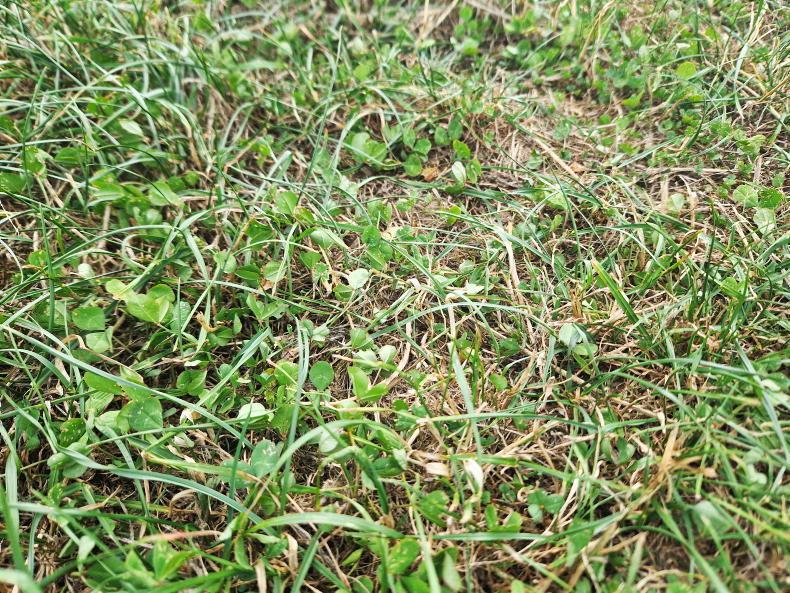
Grass and clover can wilt away if not grazed during very dry weather.
Secondly, measure how much silage is in the yard and compare that to what you need for the winter, taking into account any planned second cuts of silage.
This feed should be ringfenced for the winter period and not fed out to milking cows during the summer.
That’s not to say that ground earmarked for second-cut silage shouldn’t be grazed or zero grazed.
The likelihood is when the rain does come, there will be compensatory growth and this ground can be closed up again and cut for silage later.
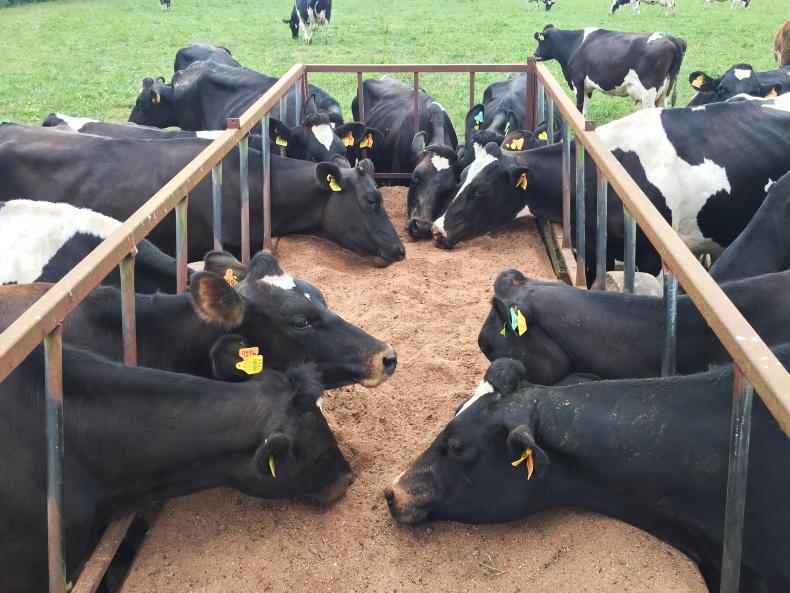
Palm kernel expeller (PKE) being fed to dairy cows.
Concentrate feeds are expensive and don’t represent good value for money, but it is inevitable that more will have to be fed during a dry spell to help bridge the gap left by lower grass growth.
Straights can also be fed and these tend to be cheaper than concentrate feeds.
Palm kernel is costing around €240/t which works out at €266/t DM, while soya hulls is more expensive at around €260/t or €289/t DM.
To put these in context, a 200kg DM round bale of silage costing €40/bale is costing €200/t DM and at €50/bale is costing €250/t DM.
A typical dairy ration costing €370/t works out at around €435/t DM. The prices for straights may increase if demand rises.
Of all the things to run out of, water is the last thing you want to be short of. Cattle need ad-lib access to fresh clean water at all times. This requirement is exacerbated in hot weather because cows sweat more to keep cool and thus drink more water to prevent dehydration.
Typical water intakes during the real hot days can be up to 130l/cow/day.
About half of the total water intake is drunk in the first hour after milking. This can put a big strain on water systems, particularly where pipe size is small.
Small pipes are a bigger problem than small troughs and they are also harder on pumps.
Keep troughs away from electric fences and ensure that any algae or other debris is removed.
As soil moisture deficits continue to increase and with little to no rain in the forecast, fears over a drought are growing.
The first thing to say is that we can’t predict the weather beyond seven to 10 days so for all we know now, it could start raining in mid-June and not stop.
However, farmers should prepare for all eventualities and, as it stands now, a dry spell which limits grass growth is the more likely outcome for most of the country.
With this in mind, the following is some advice for dairy farmers as they navigate through the next few weeks.
The advice around fertiliser use in the dry spell is clear. If there is no moisture to wash in fertiliser, it will continue to sit on the surface and we have seen that in recent weeks. Provided this fertiliser is in the form of protected urea or a CAN-based product, there is limited risk of losses to the atmosphere.

Hold off on spreading fertiliser until after the rain comes.
So, the fertiliser that was applied two weeks ago is still there and hasn’t been taken up by the plant. Therefore, additional fertiliser after the next round of grazing will just increase the amount of fertiliser sitting on the surface and will not be available for plant growth.
The more fertiliser there is sitting on the surface, the greater the risk of losses after it does rain.
This is particularly the case when ground is hard – if the weather breaks with heavy thunderstorms, there is a high risk that the nitrogen will be washed away rather than soak through the soil. In such cases, it would be better to apply nitrogen after the rain comes and on to wet soils.
Some farmers are asking about liquid fertiliser.
This comes in two forms: foliar application or liquid. Foliar applications need leaf area for uptake, while liquid fertiliser is applied to the surface and works in the same way as granular fertiliser.
The limiting factor will be moisture and not nitrogen. Plus, plenty of background nitrogen will be released from the soil during this dry spell so nitrogen is not limiting.
This is not an easy area to get right. Indeed, there are mixed views on what is actually the right thing to do. The number one priority is to maximise how much grass the cows eat on the farm for the duration of the dry spell.

Cows being fed zero-grazed grass during previous dry periods. \ Donal O'Leary
The situation is complicated by the fact that in a severe soil moisture deficit and in very hot weather grass covers can go backwards. This has the effect of undoing the benefits of building up grass covers in dry weather. This use it or lose it scenario means that it can be pointless putting in a lot of feed early in a dry spell.
The biggest mistake farmers make in a dry spell is not to clean out paddocks appropriately while at the same time putting in a lot of feed.
Cows are usually extremely content to graze out lower than normal in a dry spell.
Even if the grass is yellow and stemmy at the base, the dry matter is very high and it is very palatable.
The best policy is to continue to graze out paddocks well, extend the rotation length by a bit but not by a lot. A rotation length of 25 to 30 days is OK during the dry spell.
Make sure cows clean out all the available grass in the paddock and then use a supplement, if necessary, to fill the gap.
It is after the rain does come that the rotation length should be increased to 40 or 50 days, so as to allow the average farm cover to increase.
In order to achieve this, extra feed should be fed during this time.
The number one feed to chase is grass. Cease all cutting and topping where farms are continuing to grow well and let cover per cow and pre-grazing yield creep up higher than target. At least then there will be more feed on the farm that can be grazed if and when grass growth decreases.

Grass and clover can wilt away if not grazed during very dry weather.
Secondly, measure how much silage is in the yard and compare that to what you need for the winter, taking into account any planned second cuts of silage.
This feed should be ringfenced for the winter period and not fed out to milking cows during the summer.
That’s not to say that ground earmarked for second-cut silage shouldn’t be grazed or zero grazed.
The likelihood is when the rain does come, there will be compensatory growth and this ground can be closed up again and cut for silage later.

Palm kernel expeller (PKE) being fed to dairy cows.
Concentrate feeds are expensive and don’t represent good value for money, but it is inevitable that more will have to be fed during a dry spell to help bridge the gap left by lower grass growth.
Straights can also be fed and these tend to be cheaper than concentrate feeds.
Palm kernel is costing around €240/t which works out at €266/t DM, while soya hulls is more expensive at around €260/t or €289/t DM.
To put these in context, a 200kg DM round bale of silage costing €40/bale is costing €200/t DM and at €50/bale is costing €250/t DM.
A typical dairy ration costing €370/t works out at around €435/t DM. The prices for straights may increase if demand rises.
Of all the things to run out of, water is the last thing you want to be short of. Cattle need ad-lib access to fresh clean water at all times. This requirement is exacerbated in hot weather because cows sweat more to keep cool and thus drink more water to prevent dehydration.
Typical water intakes during the real hot days can be up to 130l/cow/day.
About half of the total water intake is drunk in the first hour after milking. This can put a big strain on water systems, particularly where pipe size is small.
Small pipes are a bigger problem than small troughs and they are also harder on pumps.
Keep troughs away from electric fences and ensure that any algae or other debris is removed.








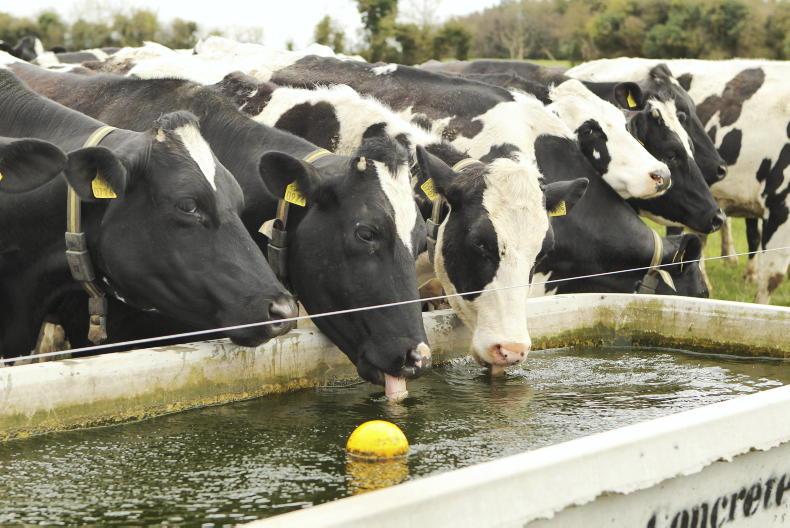


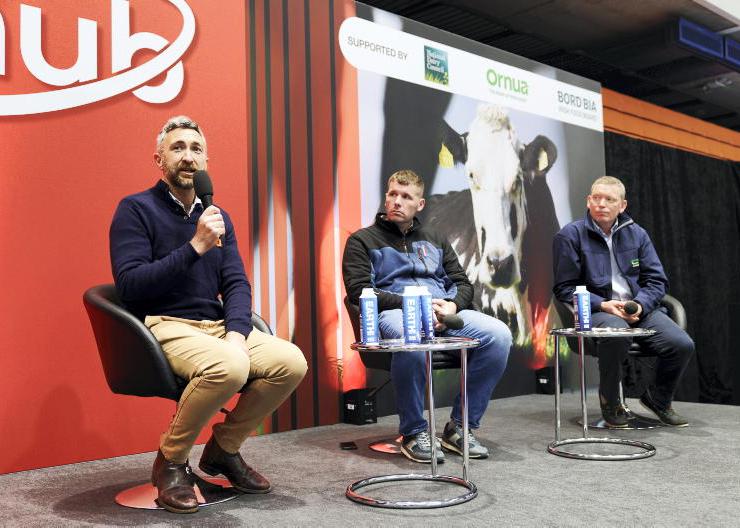
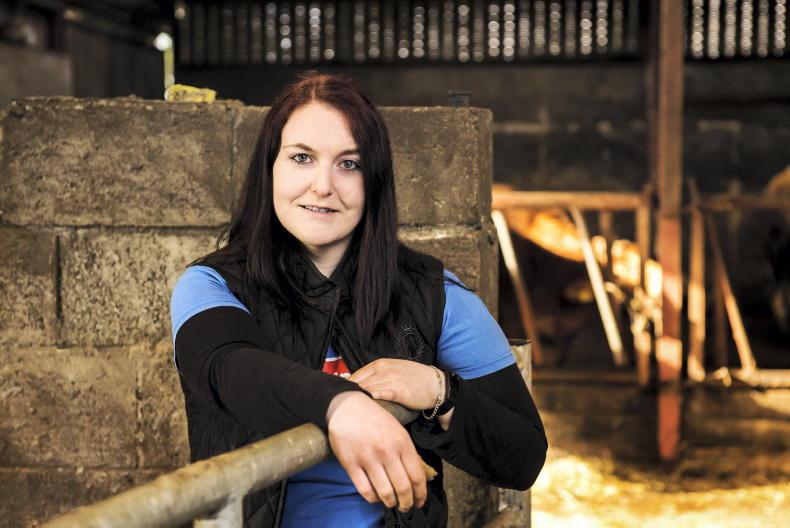
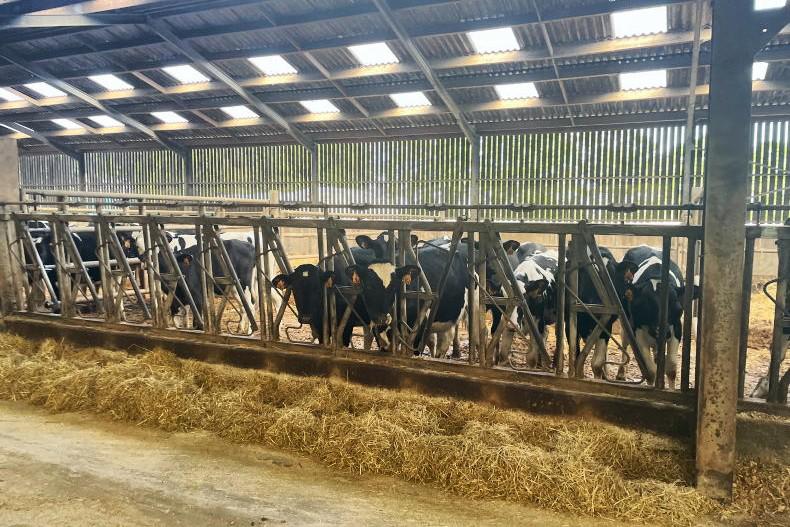
SHARING OPTIONS